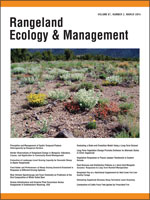State-and-transition models (STMs) are used in natural resource management to describe ecological site scale response to natural and anthropogenic disturbances. STMs are primarily based for expert opinion and literature reviews, lacking analytical testing to support vegetation community dynamics, thresholds, and state changes. We developed a unique approach, combining ordination and permutation MANOVA (perMANOVA) with raw data interpretation, to examine vegetation data structure and identify thresholds for a STM. We used a long-term monitoring dataset for an ecological site on the Santa Rita Experimental Range, Arizona. Basal cover of perennial grasses and canopy cover of shrubs and cacti were measured on permanent transects beginning in 1957. Data were grouped by drivers identified by the STM including species invasion, grazing, drought, and mesquite treatment. Ordination by nonmetric multidimensional scaling described the structure of the data. PerMANOVA was used to test for differences between groups of sample units. Analyses of combined key species (Lehmann's lovegrass and mesquite [Prosopis velutina Woot.]) and nonkey species patterns demonstrated an irreversible transition and occurrence of a structural threshold due to Lehmann's lovegrass invasion, as well as a short-term reversible transition (restoration pathway) following mesquite treatment. Sensitivity analysis, in which key species were removed from the dataset, showed that the relative composition of nonkey species did not differ between states previously defined by the key species. This apparent disconnect between dynamics of key and nonkey species may be related to changes in the functional attributes that were not monitored during this time series. Our analyses suggest that, for this ecological site, transition to a Lehmann's lovegrass state occurs when basal cover of this species exceeds 1–2%, which often occurs within 6 yr of its arrival. Evaluation of the restoration pathway showed a recrossing of the threshold within 6 yr of treatment and when mesquite canopy cover exceeded 10%.
How to translate text using browser tools
1 March 2014
Evaluating a State-and-Transition Model Using a Long-Term Dataset
Anthony T. Perlinski,
Ginger B. Paige,
Mitchel P. McClaran
ACCESS THE FULL ARTICLE

Rangeland Ecology and Management
Vol. 67 • No. 2
March 2014
Vol. 67 • No. 2
March 2014
ecological site
nonmetric multidimensional scaling
permutation multivariate analysis of variance
thresholds




